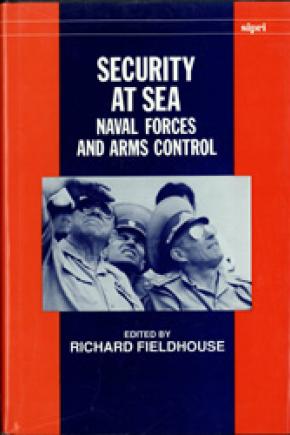Security at Sea: Naval Forces and Arms Control
Of all the military forces of East and West, only naval forces are excluded from current arms control efforts. This has generally been the case since World War II, despite the fact that the navies of the USA, the USSR, the UK, France and China possess almost one-third of all the nuclear weapons in the world, and despite the risks inherent in operating adversarial navies in close proximity all over the seas. Naval arms control is considered to be a particularly difficult endeavour, especially given the great maritime differences between the USA and the USSR—the two largest naval powers. With the improved US-Soviet political relations and dramatic progress in arms control, there is a new opportunity to include their naval forces in co-operative efforts to improve security and reduce the risk of military confrontation. It is clear that naval forces should be included in the arms control process: the question is how?
This book is the second of two volumes resulting from the SIPRI Project on Naval Forces and Arms Control. It explores the problems, possibilities and prospects for naval arms control. It contains papers by naval professionals, arms control experts, strategic analysts and experts in international law, who examine the risks of unconstrained naval competition and the challenges and potential benefits of naval arms control, and consider possible approaches, including confidence-building measures. The book concludes that there are many possibilities for incorporating naval forces and activities in arms control efforts and offers suggestions for future action. It serves as an important contribution to the emerging debate on naval forces, arms control and security.
Part I. Introduction and conclusions
Naval forces and arms control
Richard Fieldhouse
Part II. The case for naval arms control
1. Naval arms control: History and observations
Jan Prawitz
Appendix 1A. Pre-World War II naval arms limitation measures
2. US–Soviet naval competition: Dangers and risks
Eugene J. Carroll, Jr
3. Maritime change in developing countries: The implications for naval arms control
Derek Boothby
Part III. Challenges of naval arms control
4. Navies of the superpowers: The strategic background
Hervé Coutau-Bégarie
5. Verification of nuclear weapons at sea
Herbert Lin
6. Superpower naval arms control: Practical considerations and possibilities
Richard Hill
Part IV. Approaches to naval arms control
7. Naval arms control and the Convention on the Law of the Sea
Ove E. Bring
8. Controlling superpower naval operations
William M. Arkin
9. Naval nuclear arms control
Richard Fieldhouse
10. The Seabed Treaty and arms control
Jozef Goldblat
Part V. Confidence-building measures
11. Applying and extending the USA–USSR Incidents at Sea Agreements
Sean M. Lynn-Jones
12. A multilateral regime for prevention of incidents at sea
Jan Prawitz
13. Naval confidence-building measures: A CSCE perspective
Patrick Howard
Annexes
Annexe A. Official Soviet and US views on naval forces and arms control, 1988–89
I. The Soviet view
- Naval Forces and Universal Security
Marshal Sergey Akhromeyev
II. The US view
- Northern Seas are Vital for NATO's Defense
Admiral Carlisle A. H. TrostThe Neither Confirm Nor Deny (NCND) Policy
The US Position on Nuclear Weapon Free Zones (NWFZ)
Statement of Vice Admiral Charles R. Larson, US Navy, Deputy Chief of Naval Operations (Plans, Policy and Operations), before the House Armed Services Committee, on Naval Arms Control
Annexe B. Current international agreements relevant to naval forces and arms control
I. Incidents at Sea agreements
- Agreement between the USA and the USSR on the Prevention of Incidents on and over the High Seas (USA–USSR Incidents at Sea Agreement), 1972, Protocol, 1973
Agreement between the UK and the USSR concerning the Prevention of Incidents at Sea beyond the Territorial Sea (UK–USSR Incidents at Sea Agreement), 1986, Annex
Agreement between the Federal Republic of Germany and the USSR concerning the Prevention of Incidents at Sea beyond the Territorial Sea (FRG–USSR Incidents at Sea Agreement), 1988, Protocol
II. Other agreements
- Antarctic Treaty, 1959, excerpts, Parties as of 1 June 1989
Treaty banning Nuclear Weapon Tests in the Atmosphere, in Outer Space and Under Water (Partial Test Ban Treaty), 1963, excerpts, Parties as of June 1989
Treaty for the Prohibition of Nuclear Weapons in Latin America (Treaty of Tlatelolco), 1967, excerpts, Parties as of 1 June 1989
Treaty on the Prohibition of the Emplacement of Nuclear Weapons and Other Weapons of Mass Destruction on the Seabed and the Ocean Floor and in the Subsoil thereof (Seabed Treaty), 1971, Parties as of June 1989
Interim Agreement between the USA and the USSR on Certain Measures with respect to the Limitation of Strategic Offensive Arms (SALT I Agreement), 1972, excerpts, Protocol, Agreed Interpretations and Unilateral Statements regarding the Interim Agreement, excerpts
Treaty between the USA and USSR on the Limitation of Strategic Offensive Arms (SALT II Treaty), 1979, excerpts
United Nations Convention on the Law of the Sea (UNCLOS Convention), 1982, excerpts, Signatories as of 1 May 1989
The South Pacific Nuclear Free Zone Treaty (Rarotonga Treaty), 1985, excerpts, Protocol 1, Protocol 2, Protocol 3, Parties as of 1 June 1989
Agreement between the USA and the USSR on Notifications of Launches of the Intercontinental Ballistic Missiles and Submarine-Launched Ballistic Missiles (Ballistic Missile Launch Notification Agreement), 1989
Agreement between the USA and USSR on the Prevention of Dangerous Military Activities (PDMA Agreement), Annex 1, Annex 2, Agreed Statements in Connection with the Agreement, 1989

